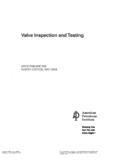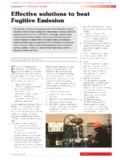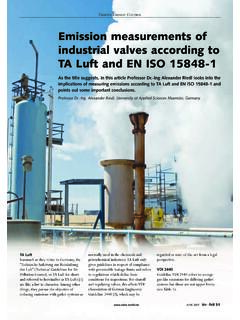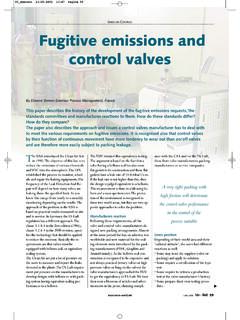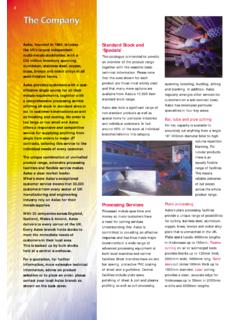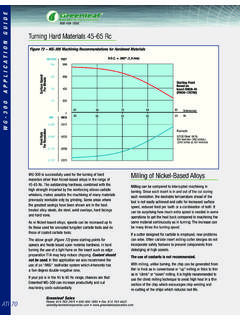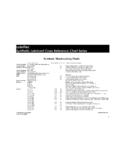Transcription of Nickel-Aluminium Bronze for Seawater: Flattered by …
1 Page { PAGE } of { NUMPAGES Nickel-Aluminium Bronze for Seawater: Flattered by Comparison By J R C Strang, Shipham Valves Keywords: Seawater, corrosion, Nickel-Aluminium Bronze , pressure-temperature ratings, stainless steel, 6Mo, duplex, super duplex, nickel alloys , titanium. Abstract In current cash strapped times, cost effectiveness is more important than it has been for a long time. The temptation of cheap materials can seem difficult to resist, but investors and operators are keenly aware of through-life costs and most are unwilling to sacrifice reliable long-term performance for a one-off gain. Clearly a compromise is called for between the expense of an ultimate solution and one that cannot be relied upon for more than a few months.}
2 Nickel-Aluminium Bronze (NAB) represents just such an alternative: in terms of cost it sits between the exotic and expensive alloys of super duplex, nickel alloys and titanium and the lower cost options of cast iron or carbon steel at the other. The aim of this paper is to show that the NAB solution is cost effective, providing a long service life without compromising on the performance or by being penalised on cost. Nickel-Aluminium Bronze is no newcomer, has been used extensively for seawater service for many years and is widely recognised to be an excellent solution. By comparing the properties and costs with a range of material options including the copper alloys , the duplex stainless steels, nickel alloys and titanium, this paper will demonstrate that NAB can be a cost effective choice.
3 The review draws on Shipham s extensive experience of manufacturing valves in most of the materials considered, as well as making reference to published literature from a variety of sources. The consequences of the most common NAB alloy not featuring in the popular flange and valve standards will be discussed. Suggestions of how to overcome this will also be made with reference to a specially developed NAB pressure-temperature rating which maximises the potential of NAB as well as recognising its limitations, enabling an economic and safe design. The fact that NAB is: cost effective (cheaper than the exotic alternatives); long lasting (comparable in performance on general corrosion, pitting and cavitation to superduplex alloys and significantly better than the standard alloys ), and a good valve material (does not gall, has excellent anti-fouling properties and is a good thermal conductor), makes it an excellent choice for valves in seawater service.
4 An extensive bibliography is included, enabling further research or investigation if required. About the Author J R C (Ron) Strang (Eur. Ing,. BSc, CEng, FIMechE, MBA), graduated as a Mechanical Engineer from Aston University in 1981 and from Hull University with an MBA in 2007. He has worked in the design and development of valves, initially with Serck Audco Valves, and then Orseal Valves. For the last 16 years he has been employed as Technical Director at Shipham Valves in Hull. Shipham manufactures extensively in Nickel-Aluminium Bronze , as did Orseal Valves. 1 Introduction It is essential to be clear that we are discussing Nickel-Aluminium Bronze (NAB), not Bronze and not aluminium Bronze , although NAB is frequently referred to as aluminium Bronze .
5 As will be shown, significant differences exist. There are several myths associated with this material. First, it is weak. Consider Figure 1: While tensile strength does not give the full picture, the material cannot be considered weak. Second, it is expensive. Again some facts see Figure 2. The reality is somewhat different to the common belief. There are other myths too such as It is not available , It is difficult to cast and Pressure-temperature ratings are not good enough . In the times of the credit crunch, cost effectiveness is more important than ever. Choosing the right material and balancing initial investment with a good through-life cost is important.
6 The sacrifice of reliable long-term performance for a one-off gain on purchase cost is clearly not an economic decision. A compromise between the expense of the ultimate solution and one that cannot be relied upon for more than a few months is required. This paper shows that this is a role that NAB as a cast valve material for seawater service can fulfil. 0100200300400500600700800 BronzeCast IronTi C2Ni-Cu AlloyTi C3C. SteelStainlessNi Alloy 6256 MoNi Alloy C22 NiAlBrnzeDuplexSuper DuplexMPaFigure 1: Tensile Strengths of Cast Materials 01002003004005006007008009001000 Cast IronCarbon StDuplexSuper DuplexNiCu6 MoNi Alloy 625Ni Alloy C22Ti C2/C31583 Figure 2: Relative Cast Costs/ Unit Volume (NAB-100) 2 What is Nickel-Aluminium Bronze ?
7 Nickel-Aluminium Bronze is not Bronze . The only similarity is that they are both copper alloys . Bronze , discovered in the 4th millennium BC, the Bronze Age, is the combination of copper and tin. The fact that aluminium Bronze shares its name with this material must be part of the reason for some of the myths. Aluminium Bronze and NAB are relatively recent innovations. They required some casting sophistication that became available in 1913 when Durville perfected his tilting ladle process to make aluminium Bronze billets. This Durville Process overcame the problem of shrinkage defects and oxide inclusions inherent to the alloys , partially due to the narrow freezing range.
8 Charles H Meigh developed this process and investigations by metallurgists ensured the development of the alloys . Its common commercial usage grew, driven by the requirement for ships propellers suitable for increasing speeds. It has become the most popular material for this use, because .. Nickel-Aluminium Bronze (NAB) is twice as resistant to corrosion fatigue as manganese Bronze and stainless steel .. (Meigh, 2000, xxix). Growth in the oil industry and the need, initially for seawater fire pumps, has also spread the use of NAB. Navies too have used NAB extensively due to its strength and weldability. The loss of the US nuclear submarine Thresher in 1963, thought to be due to a Bronze casting failure, hastened the uptake of NAB for use on submarines.
9 (Meigh, 2000) The choice of valve material is frequently determined by the choice of pipe material. Therefore as copper- nickel pipe became well established, so did the use of NAB valves. However, for reasons of weight, strength and velocity limitations (erosion damage in the Cu-Ni pipe above m/s) newer materials were considered: a 20 CuNi diameter pipe could be replaced by a 14 254 SMO material. (Gallager, Mallpas & Shone, 1986). However, experience of the newer materials (duplex, super duplex, titanium) showed that there are temperature, cost and quality limitations. More recently, NAB valves are being used with GRE pipe. The most popular alloy for valve applications is with 8% - 11% of aluminium and the addition of iron and nickel to give a high strength and good corrosion resistance.
10 This is a duplex alloy and is available in both cast and wrought forms. A summary of the main cast alloys is: American ASTM B148 UNS C95800 Nominal Cu bal 9Al 4Fe UNS C95500 Nominal Cu bal 11Al 4Ni 4Fe European EN 1982 CC333G Nominal Cu bal 10Al 5Ni 5Fe Mention must also be made of the still popular (although the standard is obsolete) BS1400 AB2, the British Navy specification DEF STAN 02-747 and the equivalent wrought specification DEF STAN 02-833. These alloys are all similar with detail differences hinging on the introduction of manganese and the balance between iron and nickel . NAB is weldable, castable and has an outstanding corrosion resistance as it has a tough oxide film.
